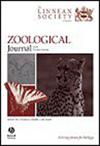The pharynx of the iconic stem-group chondrichthyan Acanthodes Agassiz, 1833 revisited with micro-computed tomography
IF 3
2区 生物学
Q1 ZOOLOGY
引用次数: 0
Abstract
Acanthodes has long been the primary source of information on the pharyngeal skeleton of ‘acanthodians’. Because of this its anatomy has played a disproportionate role in attempts to understand the evolution of the jawed vertebrate pharynx and the clade as a whole. However, the anatomy of the pharynx of Acanthodes, now understood to be a stem-group chondrichthyan, remains poorly characterized and subject to several competing interpretations. We used computed tomography to image the articulated pharyngeal skeletons of three specimens of Acanthodes confusus from Lebach, Germany. Acanthodes has a mélange of osteichthyan-like and chondrichthyan-like morphologies in its pharyngeal skeleton. Like many other chondrichthyans, Acanthodes lacked hypohyals, and had four pairs of posteriorly oriented pharyngobranchials. Like osteichthyans, Acanthodes possessed an interhyal, but lacked the separate infra- and supra-pharyngobranchial elements present in osteichthyans and the crown-chondrichthyan Ozarcus. Using these new data we built and animated a digital 3D model of the pharyngeal endoskeleton in Acanthodes, showing that the jaws could have swung outwards during the opening cycle, increasing the anteriorly facing area of the gape for suspension feeding. These new data provide a more definitive picture of the anatomy of a taxon that has long been of great significance in early vertebrate palaeontology.用微型计算机断层扫描技术重新审视标志性茎亚纲软骨鱼类 Acanthodes Agassiz, 1833 的咽部
长期以来,棘皮动物一直是 "棘皮动物 "咽部骨骼的主要信息来源。因此,在试图了解有颌脊椎动物咽部和整个支系的进化过程中,它的解剖结构起着不成比例的作用。然而,现在被认为是茎类软骨鱼类的Acanthodes的咽部解剖学特征仍然很不清楚,而且有几种相互竞争的解释。我们使用计算机断层扫描技术对来自德国莱巴赫(Lebach)的三件Acanthodes confus标本的咽部骨骼进行了成像。Acanthodes的咽部骨骼具有类似骨鱼纲和软骨鱼纲的混合形态。与许多其他软骨鱼类一样,Acanthodes 没有下鳃,有四对后向的咽鳃。与骨鱼类一样,Acanthodes 也有一个咽间器,但缺乏骨鱼类和冠软骨鱼类 Ozarcus 中独立的下咽支和上咽支。利用这些新数据,我们建立并制作了Acanthodes咽部内骨骼的数字三维模型,显示在开口周期中颌骨可能向外摆动,从而增加了咽口的前向面积,以利于悬浮取食。这些新数据为长期以来在早期脊椎动物古生物学中具有重要意义的一个类群的解剖学提供了更加确切的描述。
本文章由计算机程序翻译,如有差异,请以英文原文为准。
求助全文
约1分钟内获得全文
求助全文
来源期刊
CiteScore
6.50
自引率
10.70%
发文量
116
审稿时长
6-12 weeks
期刊介绍:
The Zoological Journal of the Linnean Society publishes papers on systematic and evolutionary zoology and comparative, functional and other studies where relevant to these areas. Studies of extinct as well as living animals are included. Reviews are also published; these may be invited by the Editorial Board, but uninvited reviews may also be considered. The Zoological Journal also has a wide circulation amongst zoologists and although narrowly specialized papers are not excluded, potential authors should bear that readership in mind.

 求助内容:
求助内容: 应助结果提醒方式:
应助结果提醒方式:


